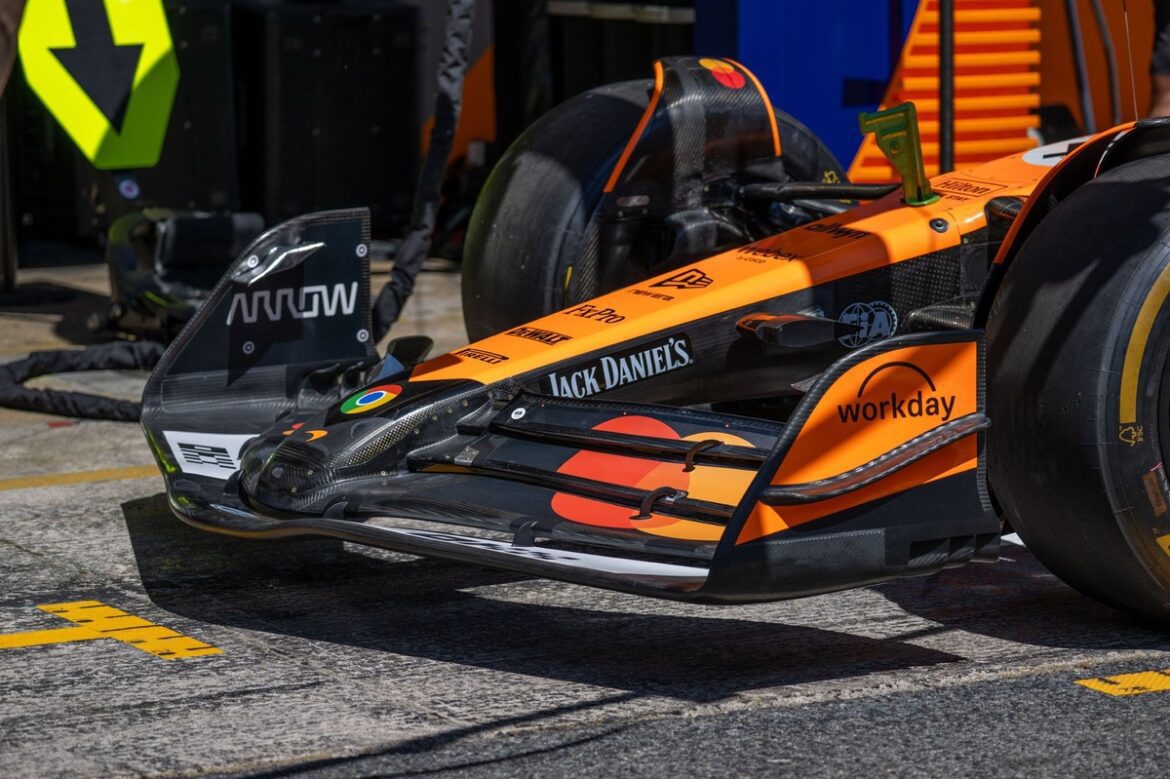McLaren and Other Teams Unveil Technical Updates for the Canadian Grand Prix
As Formula 1 gears up for the Canadian Grand Prix, several teams, including McLaren and Mercedes, have announced significant updates to their technical packages. This season has already seen teams navigating stricter regulations, particularly regarding front wing performance. With the latest adjustments, teams are aiming to enhance their cars’ aerodynamic efficiency while addressing the unique challenges presented by the Circuit Gilles Villeneuve.
McLaren’s Front Wing Innovations
McLaren has introduced a revised front wing design as part of its strategy to optimize performance in Montreal. This update comes on the heels of the Spanish Grand Prix, where all ten teams were required to adapt their front wing packages to comply with new regulatory standards. The regulations limited flexing to a maximum deviation of 10mm from a set load of 1000N, down from the previous allowance of 15mm. This change has prompted teams to innovate and refine their designs to maintain competitive performance.
Initially trialed at the Imola circuit, McLaren’s lower-flex wing showed minimal performance changes. However, the team has since refined the design further for its official debut in Canada. According to the FIA’s pre-event technical notes, McLaren’s updated front wing geometry aims to enhance aerodynamic performance across various conditions. This redesign incorporates new elements and the introduction of ‘mermaid tails’ on the endplates to improve airflow and overall efficiency.
In addition to the front wing, McLaren has also rolled out a revised medium-downforce rear wing. This new wing design is intended to offer better coverage of a broader drag range, making it adaptable to different circuits. Over the past two seasons, McLaren has continuously experimented with its rear wing configurations, striving for a versatile balance that could enhance the car’s performance under varying conditions.
Moreover, the team has made updates to its front suspension geometry, which now features new fairings tailored to the adjusted positions of the suspension components. These modifications are part of McLaren’s ongoing effort to optimize the vehicle’s handling and overall performance.
Mercedes Enhancements for Optimal Performance
Mercedes is another major team that has made technical changes ahead of the Canadian Grand Prix. Notably, the team has increased the size of its front brake inlet and outlet. This adjustment is crucial for the Circuit Gilles Villeneuve, known for its demanding braking zones. The revised brake system is expected to handle the intense braking demands more effectively, ensuring optimal performance during the race.
In addition to brake modifications, Mercedes has implemented revisions to its floor design. The updates include a lower-camber edge wing and redesigned turning vanes. These changes aim to enhance the mass flow under the forward floor, improve the vorticity shed from the fence system, and ultimately increase the floor load. These aerodynamic improvements are vital for maintaining the car’s stability and performance during high-speed sections of the track.
Aston Martin and Alpine’s Strategic Adjustments
Aston Martin has also made adjustments to its technical setup, focusing on the front brake exit. Similar to Mercedes, Aston Martin anticipates a higher level of brake usage at the Canadian circuit, which has influenced its design choices. By enhancing the brake system, the team hopes to maximize performance while ensuring driver safety and vehicle reliability.
On the other hand, Alpine has introduced a shorter upper front wing flap, a change that will be evaluated based on the team’s performance throughout the weekend. The decision to use this shorter flap will depend on how well the drivers can balance their car setup. If the shorter-chord flap provides sufficient front-end grip, it could be advantageous, especially given the track’s numerous long straights.
Racing Bulls and Other Teams’ Flexible Wing Designs
Racing Bulls, another competitive team, has also made adjustments to its front wing for the Canadian Grand Prix. This revision allows for greater flexibility in wing settings throughout the weekend. By offering the option to run the wings at varying angles, the team aims to enhance front-end response, even if it results in slightly reduced drag and downforce. This strategic choice underscores the importance of driver preference in optimizing performance.
Additionally, Racing Bulls has introduced aerodynamic changes to the winglets on the rear wheel hub. These modifications include a new endplate designed to enhance the quality and consistency of the shed vortex, which is crucial for increasing rear downforce. By focusing on these finer details, Racing Bulls aims to extract every possible advantage from their car’s design.
The Competitive Landscape of Formula 1
As teams like McLaren, Mercedes, Aston Martin, and Alpine implement these technical updates, the competitive landscape of Formula 1 continues to evolve rapidly. Each team is keenly aware of the significance of aerodynamic performance, particularly in a sport where milliseconds can determine the outcome of a race.
The Canadian Grand Prix presents unique challenges, including a mix of tight corners and long straights that require precise handling and efficient aerodynamics. Consequently, teams have dedicated substantial resources to refine their car designs, ensuring they can perform optimally in these conditions.
The ongoing adjustments also reflect the broader trend in Formula 1, where teams must be agile and responsive to changing regulations and competitive pressures. With each race, teams learn more about their cars and how to extract the most performance, leading to continuous development and innovation.
Conclusion
The technical updates introduced by teams for the Canadian Grand Prix highlight the relentless pursuit of performance in Formula 1. From McLaren’s innovative front wing design to Mercedes’ enhanced braking systems, every adjustment aims to gain a competitive edge on the track. As the race approaches, all eyes will be on these teams to see how their changes translate into performance and ultimately, race results.
